The AMD Radeon RX 590 Review, feat. XFX & PowerColor: Polaris Returns (Again)
by Nate Oh on November 15, 2018 9:00 AM ESTPower, Temperature, and Noise
As always, we'll take a look at power, temperature, and noise of the Radeon RX 590. As a custom-only specification, this means that we will be looking at solely AIB vendor designs. With the RX 590, we already know what to expect with existing RX 580 boards and coolers.
As this is a new GPU, we will quickly review stock voltages and clockspeeds as well.
| AMD RX Series Video Card Voltages | ||||
| Boost | Idle | |||
| Radeon RX 590 | 1.1563V | 0.8000V | ||
| Radeon RX 580 | 1.1625v | 0.7625v | ||
| Radeon RX 480 | 1.0625v | |||
Power Consumption
For all the gaming performance gains that the RX 590 has made, it came with the higher clockspeeds, and to bring those higher clockspeeds came more power. Already, TBPs have notably increased from the RX 480's 150W to the RX 580's 185W, and now to the RX 590's 225W. Which is already past RX Vega 56's 210W reference board power spec.
Idle power consumption doesn't show anything out of the ordinary.
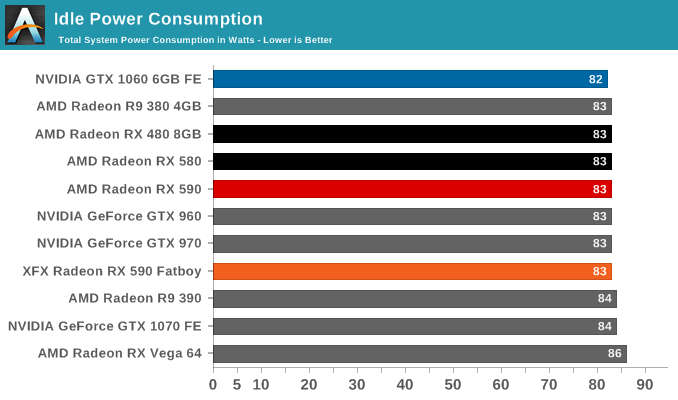
The RX 590's load power consumption is a slightly different story. For the RX 580 launch, we mused that this is where AMD paid the piper. For the RX Vega launch, I commented that the piper had then taken AMD to the cleaners. For the RX 590 today, I thought there wasn't any more the piper wanted to take, but there was.
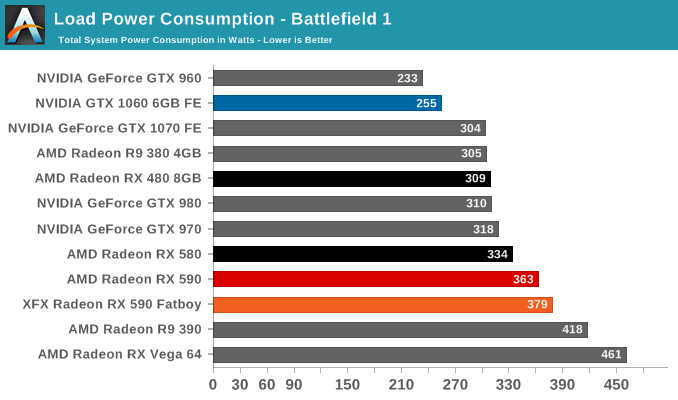
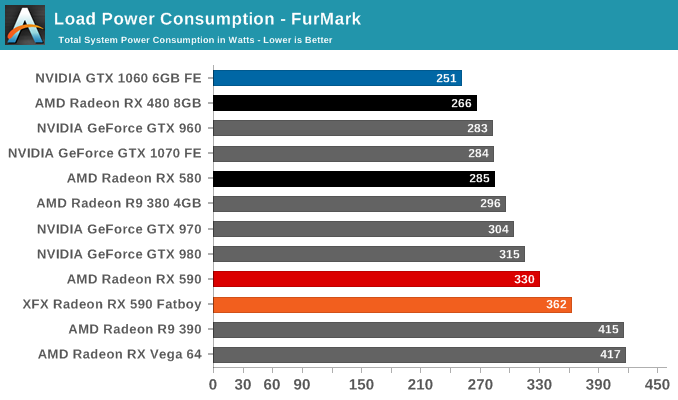
From the wall, the RX 590 now pulls 30 to 45W more than the RX 580 in Battlefield 1. The difference in FurMark is even starker, with the RX 590 now drawing 45 to 80W more. Naturally, the power delta gets higher when comparing to the RX 480, let alone the GTX 1060 6GB FE. In Battlefield 1, that's 110W or more system consumption than the GTX 1060 6GB FE for what is panning out to be around 10% faster performance. It's clear that the RX 590 is not in the same league - or anywhere close - to the GTX 1060 in terms of power efficiency.
Temperature
With all that power, heat and temperature can easily become an issue. But as both a non-reference launch and a product refresh, the featured open air axial fan designs are tried-and-true, and already configured to dissapate similar thermals.
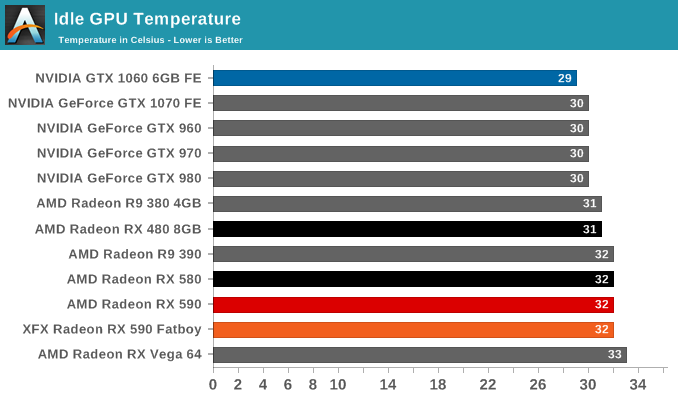

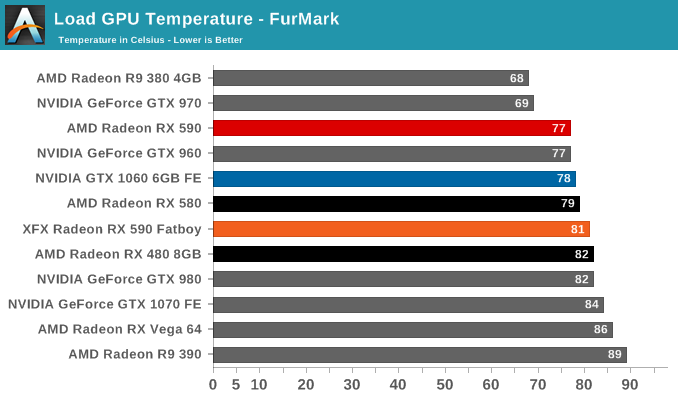
Noise
Likewise with noise, the RX 590 can benefit from zero dB functionality, where fans turn off under certain temperatures.
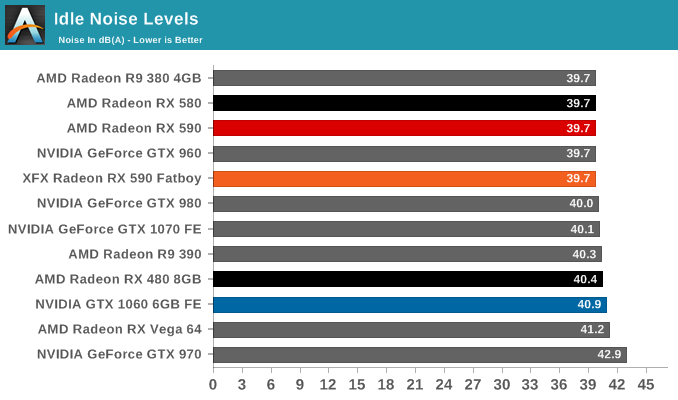
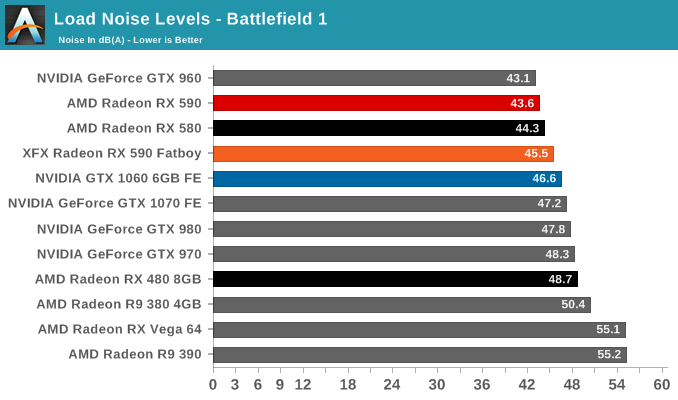
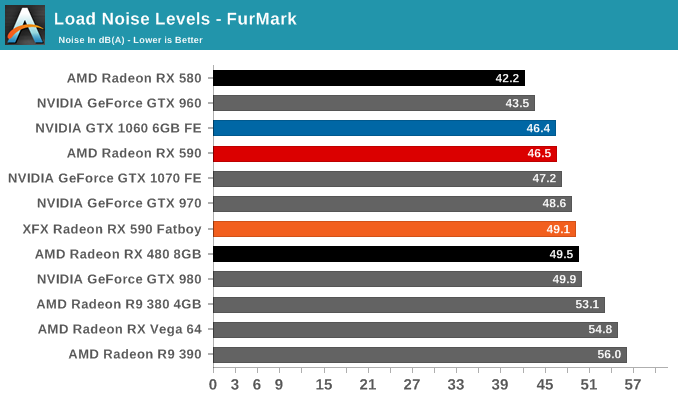
Additionally, a quick glance at RX 590 power consumption at -25% and -50% power limits show that like the RX Vega, RX 480, and RX 580, Polaris 30 is well past the optimal point on the voltage curve with the clocks at hand.










136 Comments
View All Comments
neblogai - Thursday, November 15, 2018 - link
For me, and many other people 2080 or 2080Ti might as well not exist. I'd never buy any GPU priced like that. In fact, I'd never even buy a €300+ card. Also- power use is not an issue- at 200W+, it is easy to cool, not noisy, and savings in electricity cost from having a GTX1060 would be only €5-10 per year (at 20 hour gaming per week, which I do not achieve). And in a sub-€300 market- nVidia has not offered anything for 2.5 years. So it is certainly better deal to buy a faster RX590 and get a €180 AAA game bundle for free, compared to similarly priced, slower GTX1060. There are other reasons as well, like Freesync, and futureproofing like 8GB of VRAM and better driver support (because nVidia will be moving toward doing optimizations for 20xx series).eva02langley - Thursday, November 15, 2018 - link
It is a polaris card. Everybody knew what to expect. I am not sure what you are talking about.Navi is due next year and the contender will be the 2070 RTX. I am going to speculate a tag price of 300$ which is a whole 200-300$ less than a RTX.
mapesdhs - Thursday, November 15, 2018 - link
Xex360, AMD is not trying to compete because just don't buy them, so what's the point? There market and brand awareness simply isn't there to support a high end product stack atm, not until gamers stop being so irrational and actually buy AMD when they are objectively the more sensible option, whether based on price, performance or some combination of metrics.Cooe - Thursday, November 15, 2018 - link
"but now built on GlobalFoundries' 12nm process"Sorry, Nate, but ya got that one wrong. Polaris 30 is being fabbed at TSMC, just like the rest of AMD's GPUs.
eva02langley - Thursday, November 15, 2018 - link
... sure....porcupineLTD - Thursday, November 15, 2018 - link
Where are people getting this from?Ryan Smith - Thursday, November 15, 2018 - link
Note that we currently have no information cooroborating the use of TSMC. And indeed it seems incredibly unlikely given AMD's WSA, and the fact that Polaris 30 has the exact same die size as Polaris 10. TSMC and GF's 12nm processes are not identical, porting a chip to TSMC would given you different geometry dimensions.lmcd - Friday, November 16, 2018 - link
Just like the rest of AMD's...https://www.anandtech.com/show/10446/the-amd-radeo...
GPUs. Right.
maroon1 - Thursday, November 15, 2018 - link
What a jokeOnly 12% faster but also cost and consume more power than RX580 (and 108watt more than GTX 1060 at load)
It adds noting new. It just fills the big gap between RX580 and vega56
dr.denton - Saturday, November 17, 2018 - link
"It adds noting new. It just fills the big gap between RX580 and vega56"Literally all it was ever intended to do. Polaris is a 2 year old mid range GPU design, how do you expect anything revolutionary from that?